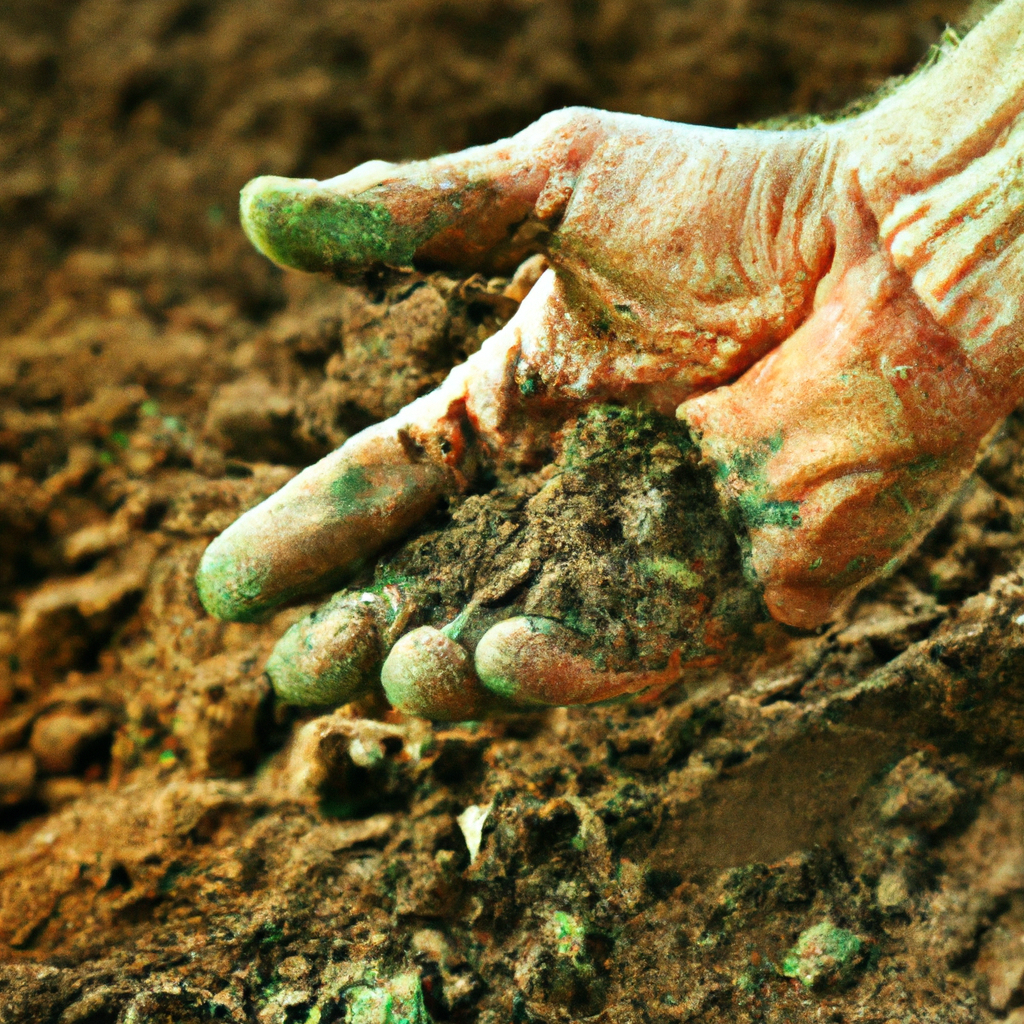In the captivating article “Can You Eat Dirt to Survive?”, we explore the intriguing concept of consuming dirt for survival. Delving into this unconventional practice, we will provide you with an in-depth understanding of the topic.
From its historical and cultural significance to its potential benefits and risks, this article will shed light on the age-old question of whether or not eating dirt can truly sustain human life. So, let’s embark on this fascinating journey and uncover the truth behind this curious phenomenon.
What is dirt?
Dirt, also known as soil, is the top layer of the Earth’s surface that is composed of a mixture of minerals, organic matter, water, and air. It is the medium in which plants grow, and it provides essential nutrients and support for life on Earth. Dirt varies in composition and characteristics depending on factors such as location, climate, and geological history.
Composition of dirt
Dirt is primarily composed of mineral particles derived from rocks and minerals broken down over time. These mineral particles can range in size and include sand, silt, and clay. Organic matter, such as decaying plant and animal material, also contributes to the composition of dirt. Additionally, dirt contains water and air, which are crucial for the growth and survival of plants and other organisms.
Types of dirt
There are various types of dirt, each with its own characteristics and suitability for different purposes. Some common types of dirt include sandy soil, clay soil, loamy soil, and peat soil. Sandy soil has larger particles and drains quickly, while clay soil has smaller particles and retains more moisture. Loamy soil is a balanced combination of sand, silt, and clay and is considered ideal for gardening. Peat soil is characterized by its high organic matter content and is often found in wetland areas.
Dangers of eating dirt
While dirt serves as a medium for plant growth and is essential for life on Earth, consuming it can pose certain dangers to human health. It is important to understand these risks and exercise caution.
Possible contaminants
Dirt can contain various contaminants that may be harmful if ingested. These contaminants can include heavy metals, pesticides, bacteria, fungi, and parasites. Human activities such as industrial pollution, improper waste disposal, and the use of chemical fertilizers and pesticides can contribute to the presence of these contaminants in the dirt.
Health risks
Eating dirt, a practice known as geophagy, can pose health risks. The consumption of contaminated dirt can lead to digestive issues, such as stomach pain, diarrhea, and vomiting. Ingesting certain contaminants found in dirt, such as lead or mercury, can have long-term detrimental effects on the nervous system, especially in children. It is crucial to avoid eating dirt, especially when its safety and cleanliness cannot be assured.

Traditional uses of eating dirt
Although the dangers of eating dirt are well-known, there are cultural and medical practices where the consumption of dirt has traditionally been observed.
Geophagy in cultural practices
Geophagy, the intentional consumption of dirt, has been an integral part of some cultural practices worldwide. It is often associated with rituals and beliefs, where people consume specific types of dirt for spiritual, medicinal, or cultural reasons. In certain societies, geophagy is seen as a way to connect with ancestral spirits or to fulfill specific dietary or medicinal needs.
Medical applications
In some medical practices, certain types of dirt have been used for therapeutic purposes. Known as medical geophagy, this practice involves using dirt as a source of natural remedies or to address specific nutritional deficiencies. However, it is essential to note that any medical applications involving dirt should be done under the guidance and supervision of qualified healthcare professionals.
Nutritional value of dirt
While dirt may not be considered a typical source of nutrition, it does contain some valuable components that can contribute to overall health.
Mineral content
Dirt is rich in essential minerals that are vital for various bodily functions. These minerals include calcium, magnesium, potassium, iron, and many others. In regions where the soil is nutrient-rich, the crops grown in that soil can have higher mineral content, which can be beneficial when consumed as part of a balanced diet.
Presence of beneficial microorganisms
Dirt is also home to numerous beneficial microorganisms such as bacteria, fungi, and actinomycetes. These microorganisms play crucial roles in nutrient cycling, decomposition of organic matter, and the creation of a healthy soil ecosystem. When consumed in small amounts, these microorganisms may have positive effects on the gut microbiome, which can contribute to overall well-being.

Geophagy among animals
Geophagy is not unique to humans and can also be observed among various animal species. While the exact reasons for this behavior are not entirely understood, it is believed to serve specific purposes in animal physiology and survival.
Understanding animal behavior
Animals, such as birds, reptiles, and mammals, engage in geophagy for various reasons. Some theories suggest that animals consume dirt to aid digestion, supplement their diet with nutrients not obtained from their primary food sources, detoxify harmful substances, or to fulfill reproductive or behavioral needs. The specific motivations for geophagy can vary greatly across different animal species.
Reasons behind geophagy
In some cases, animals may consume specific types of dirt or clay to counteract the effects of toxic substances or to neutralize the acidity in their digestive systems. Geophagy can also be observed during certain life stages, such as pregnancy or breeding, where animals have specific nutritional requirements that cannot be met solely through their regular diet.
The psychological aspects of eating dirt
In some instances, the consumption of dirt may be associated with psychological disorders or specific cravings.
Pica disorder
Pica is a disorder characterized by persistent cravings and consumption of non-food substances, including dirt. This disorder is often associated with nutritional deficiencies, mental health conditions, or developmental disorders. Pica can be harmful and may result in health complications due to the ingestion of substances that are not intended for consumption.
Context dependency of cravings
Individuals may occasionally experience cravings for non-food substances, including dirt, due to cultural or psychological factors. These cravings may arise in specific contexts or situations and can vary from person to person. It is crucial to recognize and address the underlying causes of such cravings to ensure overall well-being and to avoid the potential dangers associated with eating dirt.

Survival situations and eating dirt
In extreme survival situations, where food scarcity is a reality, the consumption of dirt may be considered as a last resort option.
Lack of food in extreme situations
In situations such as natural disasters, wilderness survival, or in isolated environments, access to food can be severely limited. In dire circumstances where no other edible options are available, some individuals may resort to eating dirt as a means to sustain themselves temporarily.
Using dirt as a last resort
Eating dirt in survival situations should be approached with utmost caution and only when there are no alternatives. Dirt cannot provide sufficient nutrition to sustain long-term survival, and its consumption should only be viewed as a temporary measure until adequate food sources can be obtained or assistance can be received.
Alternatives to eating dirt for survival
While dirt may be considered as a desperate option in survival situations, it is crucial to explore other viable alternatives that can provide essential nutrition in a more sustainable manner.
Foraging for edible plants
In many environments, there are various edible plants, fruits, and roots that can be safely foraged for sustenance. Learning about local flora and their edible properties can be invaluable in ensuring a more nutritious and safer survival strategy.
Animal-based food sources
Seeking animal-based food sources, such as fishing, hunting, or trapping, can provide a more reliable and nutrient-dense option for survival. Utilizing survival skills and tools to procure food from the natural environment can increase the chances of finding sustainable nutrition.

The role of dirt in soil fertility
Beyond its potential risks and uses for survival, dirt plays a crucial role in the fertility and productivity of soil.
Nutrient cycling
Dirt, along with organic matter, plays a vital role in nutrient cycling within the soil. Through decomposition and the activities of microorganisms, dirt helps to break down organic materials, releasing nutrients that can be absorbed by plants. This nutrient cycling process ensures the continual availability of essential elements for plant growth and overall soil fertility.
Soil structure
The composition of dirt significantly influences the structure and texture of soil. Different proportions of sand, silt, and clay in dirt contribute to the soil’s ability to retain water, allow for proper drainage, and support root development. The presence of organic matter in dirt enhances soil structure, creating a favorable environment for plant growth.
Conclusion
While dirt may have some perceived benefits and traditional uses, caution should be exercised when it comes to consuming it. The risks associated with contaminants and potential health hazards outweigh any potential nutritional value or temporary survival benefits that dirt may offer. It is essential to seek out safe and reliable sources of nutrition, especially in everyday life and survival situations. By understanding the composition, dangers, and alternative options to dirt consumption, individuals can make informed decisions for their well-being and overall health.

